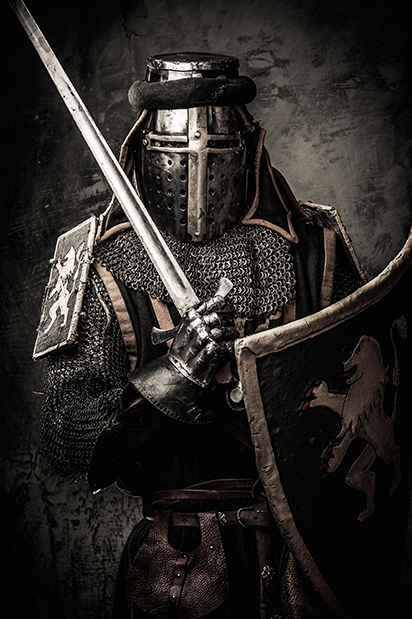
Some of the most exciting historical costumes today, come from the medieval period or the Middle Ages in European history, which lasted from the 5th to the 15th century. It was a brutal time in the history of mankind by any admission, replete with wars, invasions, and conquests. A time of turmoil, burgeoning nationalism, and massive social change. These dramatic times were marked by legends of chivalry, intrigue, and romance. Against this backdrop arose some of the most towering legends in medieval history - kings, knights, & lords, who lived in fairytale castles, wore dramatic costumes and went to war. Hollywood’s enduring tribute to the lives and times of Bravehearts from this era has also spun some of the most visually stunning fashion vistas for audiences across the world.
Medieval fashion was dominated and highly influenced by the kings and queens of the era. Only the wealthy were allowed to dress in fashionable clothes. Fashion followed the dictate of the Pyramid of Power, the Feudal System. While the king historically wore clothes that set him apart from commoners, as the Middle Ages progressed his clothes became increasingly regal and rich. Eventually, laws were passed to dictate commoners what they could or could not wear. The Sumptuary Laws passed by King Edward III, restricted ordinary people in their expenditure, including the money spent on their clothes, which impacted medieval fashion. The law allowed only royalty to wear cloth of gold and purple silk. Fashion and social classes were irreversibly fused; you could tell who belonged to which class by simply looking at their clothes. Royalty, nobility, worker class, peasant class, single or married, each had a separate dressing code. Clothes worn by wealthy merchants and the upper class were very elaborate and lavishly adorned with jewelry and intricately woven silk.
One of the most iconic medieval historical costume that stands heads and shoulders above everything else, is the knight’s armor. Knights were bound by The Code of Chivalry that included virtues of bravery, generosity, valour, and courtesy to women. Although the medieval period was known for violence and death, codes such as these brought about the much needed silver lining in an otherwise astoundingly dark age. A knight’s armor set him apart, making him appear like an indestructible moving force that few could stand up to without fear. It became an iconic symbol of the heat of the battleground, representing his military unit and an announcement of his social status, as only the very wealthy could afford such expensive armor and equipment.
Knights wore particularly sleeveless ‘surcoats’ decorated with long-sleeved chain mails. This attire came with a belt and buckle, upon which pouches were attached. For a short duration, linen tunics fastened with metal collars were added to the whole ensemble. Knights were loaded with a shield, sword, spear and a helmet. Expensive leather was exclusively reserved for knights and nobles. A most fascinating part of the costume was the dazzling centerpiece chest chainmail that dominated the armor costume design most of the period. It was called chain mail or ring mail because it was made of a series of small rings interlocked together, an assembly pattern that proved very effective against slicing and stabbing weapons and normal arrows. Eventually, with the rise of the use of crossbows and other weapons, armorers started adding various padding or other material under the chainmail or over it. In course of time, it became too cumbersome and these were discarded in favor of pieces of plates, moving towards the creation of the coat of plates which lasted through the 14th century.
Helmets during the medieval period also underwent a lot of changes, changing the design with a deepening understanding of what worked better in combat, as also the ability to work with metal. Early designs were flat, slowly developing the popular round and curved shape that could successfully deflect a blow instead of taking the full brunt. Later, the helmets were multiple pieces riveted together, with moving parts like a visor.
A close look at armory, however, reveals more than what meets our romantic eye. Recent research findings by biomechanics experts & historical re-enactors now tell us that our medieval knight’s shining armors could very well have been his worst enemy. Most medieval knights were hardly more than young boys who took oaths of loyalty to wealthy noblemen and warlords in return of promise of money or war booty. Majestic, glittering full-body suits may have deflected enemy arrows but they also exhausted these young soldiers. Loaded with metal gear weighing between 66 and 100 pounds, soldiers had to expend twice the energy to get through the battlefield.
According to Federico Formenti, from the University of Auckland, “Being wrapped in a tight shell of armor may have made soldiers feel safe. But you feel breathless as soon as you begin to move around in medieval armor, and this would likely limit a soldier’s resistance.” By the mid-16th century, soldiers started throwing off the full-body unwieldy full-body armor in favor of breastplates, steel vests and other defensive garments, designed for maximum agility. Ultimately, with time these majestic uniforms fell out of use with the dawn of the age of firearms, that paved the way for booming guns, hand cannons and a radical new way of warfare.



